A Modified ABCD Model with Temperature-Dependent Parameters for Cold Regions: Application to Reconstruct the Changing Runoff in the Headwater Catchment of the Golmud River, China
Abstract
1. Introduction
2. Study Area and Data
2.1. The Study Area
2.2. Data and Treatment
3. Methodology
3.1. ABCD Model
3.2. Modified ABCD Model for Cold Regions (ABCD-CR)
3.3. Calibration and Performance Assessment of Models
3.4. Sensitivity Analysis on Runoff to Temperature
4. Results
4.1. Validation and Calibration Results of the ABCD-CR Model
4.2. Comparison among Different Models
4.3. Restored Runoff at W-III for the Period 1990–2015
4.4. Effect of Temperature Changes on Runoff
4.5. Streamflow Versus Groundwater Level
5. Discussion
5.1. Comparison with Previous Similar Studies
5.2. Uncertainties and Limitations
6. Conclusions
- (1)
- Incorporating the temperature and groundwater-evapotranspiration effects could significantly enhance the performance of the hydrological model for catchments in cold regions. Among several comparable hydrological models, the ABCD-CR model provides the best simulation on the monthly runoff in the headwater catchment of the Golmud River observed before 1990. For the period after 1990, the ABCD model overestimated the mean annual runoff and underestimated the mean annual evapotranspiration.
- (2)
- With increasing in the air temperature during 1975–2015, the annual snowmelt runoff in the study catchment showed an increasing trend and a change in seasonal distribution. The concentrated release period of the snowmelt runoff gradually shifted from May to April. The spring flood in the Golmud River will shorten the time while raise the peak.
- (3)
- The ABCD-CR model can capture the increasing effect of the hydraulic conductivity of soils with the frozen soil degradation caused by the global warming. As revealed, the frozen soil degradation led to an increase in the cold season runoff whereas did not affect the warm season runoff.
- (4)
- The annual runoff in the headwater catchment of the Golmud River was positively correlated with the groundwater level in the area of the Golmud city. The increasing streamflow in the Golmud River was the major cause for the rising groundwater level in the Golmud city over the past 20 years.
Supplementary Materials
Author Contributions
Funding
Conflicts of Interest
References
- Viviroli, D.; Dürr, H.H.; Messerli, B.; Meybeck, M.; Weingartner, R. Mountains of the world, water towers for humanity: Typology, mapping, and global significance. Water Resour. Res. 2007, 43. [Google Scholar] [CrossRef]
- Apel, H.; Thieken, A.H.; Merz, B.; Blöschl, G. A Probabilistic Modelling System for Assessing Flood Risks. Nat. Hazards 2006, 38, 79–100. [Google Scholar] [CrossRef]
- Ignacio, J.A.F.; Cruz, G.T.; Nardi, F.; Henry, S. Assessing the effectiveness of a social vulnerability index in predicting heterogeneity in the impacts of natural hazards: Case study of the Tropical Storm Washi flood in the Philippines. Vienna Yearb. Popul. Res. 2016, 13, 91–129. [Google Scholar] [CrossRef]
- Nardi, F.; Morrison, R.R.; Annis, A.; Grantham, T.E. Hydrologic scaling for hydrogeomorphic floodplain mapping: Insights into human-induced floodplain disconnectivity. River Res. Appl. 2018, 34, 675–685. [Google Scholar] [CrossRef]
- Immerzeel, W.W.; van Beek, L.P.H.; Bierkens, M.F.P. Climate change will affect the Asian water towers. Science 2010, 328, 1382–1385. [Google Scholar] [CrossRef]
- Liu, X.; Chen, B. Climatic warming in the Tibetan Plateau during recent decades. Int. J. Climatol. 2000, 20, 1729–1742. [Google Scholar] [CrossRef]
- Guo, D.; Wang, H. The significant climate warming in the northern Tibetan Plateau and its possible causes. Int. J. Climatol. 2012, 32, 1775–1781. [Google Scholar] [CrossRef]
- Zhu, X.; Wang, W.; Fraedrich, K. Future Climate in the Tibetan Plateau from a Statistical Regional Climate Model. J. Clim. 2013, 26, 10125–10138. [Google Scholar] [CrossRef][Green Version]
- Song, C.; Pei, T.; Zhou, C. The role of changing multiscale temperature variability in extreme temperature events on the eastern and central Tibetan Plateau during 1960–2008. Int. J. Climatol. 2014, 34, 3683–3701. [Google Scholar] [CrossRef]
- Cai, D.; You, Q.; Fraedrich, K.; Guan, Y. Spatiotemporal Temperature Variability over the Tibetan Plateau: Altitudinal Dependence Associated with the Global Warming Hiatus. J. Clim. 2017, 30, 969–984. [Google Scholar] [CrossRef]
- Wan, G.; Yang, M.; Liu, Z.; Wang, X.; Liang, X. The Precipitation Variations in the Qinghai-Xizang (Tibetan) Plateau during 1961–2015. Atmosphere 2017, 8, 80. [Google Scholar] [CrossRef]
- Immerzeel, W.W.; van Beek, L.P.; Konz, M.; Shrestha, A.B.; Bierkens, M.F. Hydrological response to climate change in a glacierized catchment in the Himalayas. Clim. Chang. 2012, 110, 721–736. [Google Scholar] [CrossRef] [PubMed]
- Guo, D.; Wang, H. Simulation of permafrost and seasonally frozen ground conditions on the Tibetan Plateau, 1981–2010. J. Geophys. Res. Atmos. 2013, 118, 5216–5230. [Google Scholar] [CrossRef]
- Shen, M.; Zhang, G.; Cong, N.; Wang, S.; Kong, W.; Piao, S. Increasing altitudinal gradient of spring vegetation phenology during the last decade on the Qinghai–Tibetan Plateau. Agric. For. Meteorol. 2014, 189–190, 71–80. [Google Scholar] [CrossRef]
- Qin, Y.; Lei, H.; Yang, D.; Gao, B.; Wang, Y.; Cong, Z.; Fan, W. Long-term change in the depth of seasonally frozen ground and its ecohydrological impacts in the Qilian Mountains, northeastern Tibetan Plateau. J. Hydrol. 2016, 542, 204–221. [Google Scholar] [CrossRef]
- Qin, Y.; Yang, D.; Gao, B.; Wang, T.; Chen, J.; Chen, Y.; Wang, Y.; Zheng, G. Impacts of climate warming on the frozen ground and eco-hydrology in the Yellow River source region, China. Sci. Total Environ. 2017, 605–606, 830–841. [Google Scholar] [CrossRef]
- Zhang, W.; Yi, Y.; Song, K.; Kimball, J.S.; Lu, Q. Hydrological Response of Alpine Wetlands to Climate Warming in the Eastern Tibetan Plateau. Remote. Sens. 2016, 8, 336. [Google Scholar] [CrossRef]
- Kang, S.; Xu, Y.; You, Q.; Flügel, W.-A.; Pepin, N.; Yao, T. Review of climate and cryospheric change in the Tibetan Plateau. Environ. Res. Lett. 2010, 5, 15101. [Google Scholar] [CrossRef]
- Walvoord, M.A.; Kurylyk, B.L. Hydrologic Impacts of Thawing Permafrost—A Review. Vadose Zone J. 2016, 15. [Google Scholar] [CrossRef]
- Cuo, L.; Zhang, Y.; Bohn, T.J.; Zhao, L.; Li, J.; Liu, Q.; Zhou, B. Frozen soil degradation and its effects on surface hydrology in the northern Tibetan Plateau. J. Geophys. Res. Atmos. 2015, 120, 8276–8298. [Google Scholar] [CrossRef]
- Yang, H.; Yang, D. Derivation of climate elasticity of runoff to assess the effects of climate change on annual runoff. Water Resour. Res. 2011, 47. [Google Scholar] [CrossRef]
- Yang, H.; Qi, J.; Xu, X.; Yang, D.; Lv, H. The regional variation in climate elasticity and climate contribution to runoff across China. J. Hydrol. 2014, 517, 607–616. [Google Scholar] [CrossRef]
- Yao, T.; Xue, Y.; Chen, D.; Chen, F.; Thompson, L.; Cui, P.; Koike, T.; Lau, W.K.-M.; Lettenmaier, D.; Mosbrugger, V.; et al. Recent Third Pole’s Rapid Warming Accompanies Cryospheric Melt and Water Cycle Intensification and Interactions between Monsoon and Environment: Multidisciplinary Approach with Observations, Modeling, and Analysis. Bull. Am. Meteorol. Soc. 2019, 100, 423–444. [Google Scholar] [CrossRef]
- Cuo, L.; Zhang, Y.; Zhu, F.; Liang, L. Characteristics and changes of streamflow on the Tibetan Plateau: A review. J. Hydrol. 2014, 2, 49–68. [Google Scholar] [CrossRef]
- Sichangi, A.W.; Wang, L.; Yang, K.; Chen, D.; Wang, Z.; Li, X.; Zhou, J.; Liu, W.; Kuria, D. Estimating continental river basin discharges using multiple remote sensing data sets. Remote Sens. Environ. 2016, 179, 36–53. [Google Scholar] [CrossRef]
- Gleason, C.; Smith, L. Toward Global Mapping of River Discharge Using Satellite Images and At-Many-Stations Hydraulic Geometry. Proc. Natl. Acad. Sci. USA 2014, 111, 4788–4791. [Google Scholar] [CrossRef]
- Bomers, A.; van der Meulen, B.; Schielen, R.M.J.; Hulscher, S.J.M.H. Historic Flood Reconstruction with the Use of an Artificial Neural Network. Water Resour. Res. 2019, 55, 9673–9688. [Google Scholar] [CrossRef]
- Kratzert, F.; Klotz, D.; Brenner, C.; Schulz, K.; Herrnegger, M. Rainfall—Runoff modelling using Long Short-Term Memory (LSTM) networks. Hydrol. Earth Syst. Sci. 2018, 22, 6005–6022. [Google Scholar] [CrossRef]
- Wang, L.; Koike, T.; Yang, K.; Jin, R.; Li, H. Frozen soil parameterization in a distributed biosphere hydrological model. Hydrol. Earth Syst. Sci. 2009, 14, 557–571. [Google Scholar] [CrossRef]
- Qi, J.; Wang, L.; Zhou, J.; Song, L.; Li, X.; Zeng, T. Coupled Snow and Frozen Ground Physics Improves Cold Region Hydrological Simulations: An Evaluation at the upper Yangtze River Basin (Tibetan Plateau). J. Geophys. Res. Atmos. 2019, 124, 12985–13004. [Google Scholar] [CrossRef]
- Gao, B.; Yang, D.; Qin, Y.; Wang, Y.; Li, H.; Zhang, Y.; Zhang, T. Change in frozen soils and its effect on regional hydrology, upper Heihe basin, nor theastern Qinghai—Tibetan Plateau. Cryosphere 2018, 12, 657–673. [Google Scholar] [CrossRef]
- Liu, B.; Quan, J.; Yang, C.; Lei, X.; Wang, H. Simulation of runoff of major basins in Qinghai Province based on SWAT model. Water Resour. Prot. 2016, 32, 39–44. (In Chinese) [Google Scholar] [CrossRef]
- De Paola, F.; Giugni, M.; Pugliese, F.; Annis, A.; Nardi, F. GEV Parameter Estimation and Stationary vs. Non-Stationary Analysis of Extreme Rainfall in African Test Cities. Hydrology 2018, 5, 28. [Google Scholar] [CrossRef]
- Guo, D.; Westra, S.; Maier, H.R. An inverse approach to perturb historical rainfall data for scenario-neutral climate impact studies. J. Hydrol. 2018, 556, 877–890. [Google Scholar] [CrossRef]
- Budyko, M.I. (Ed.) Climate and Life; Elsevier: New York, NY, USA, 1974. [Google Scholar]
- Wu, P.; Liang, S.; Wang, X.-S.; Feng, Y.; McKenzie, J.M. Climate-induced hydrologic change in the source region of the Yellow River: A new assessment including varying permafrost. Water 2018, 10, 877. [Google Scholar] [CrossRef]
- Wang, T.; Yang, H.; Yang, D.; Qin, Y.; Wang, Y. Quantifying the streamflow response to frozen ground degradation in the source region of the Yellow River within the Budyko framework. J. Hydrol. 2018, 558, 301–313. [Google Scholar] [CrossRef]
- Gao, B.; Qin, Y.; Wang, Y.; Yang, D.; Zheng, Y. Modeling Ecohydrological Processes and Spatial Patterns in the Upper Heihe Basin in China. Forests 2016, 7, 10. [Google Scholar] [CrossRef]
- Zheng, D.; van der Velde, R.; Su, Z.; Wen, J.; Wang, X.; Yang, K. Impact of soil freeze-thaw mechanism on the runoff dynamics of two Tibetan rivers. J. Hydrol. 2018, 563, 382–394. [Google Scholar] [CrossRef]
- Kirchner, J.W. Getting the right answers for the right reasons: Linking measurements, analyses, and models to advance the science of hydrology. Water Resour. Res. 2006, 42. [Google Scholar] [CrossRef]
- Thomas, H.A. Improved Methods for National Water Assessment; US Water Resources Council: Washington, DC, USA, 1981.
- Alley, W.M. Treatment of evapotranspiration, soil moisture accounting and aquifer recharge in monthly water balance models. Water Resour. Res. 1984, 1137–1149. [Google Scholar] [CrossRef]
- Zhao, J.; Wang, D.; Yang, H.; Sivapalan, M. Unifying catchment water balance models for different time scales through the maximum entropy production principle. Water Resour. Res. 2016, 52, 7503–7512. [Google Scholar] [CrossRef]
- Sankarasubramanian, A.; Vogel, R.M. Annual hydroclimatology of the United States. Water Resour. Res. 2002, 38, 19-11–19-12. [Google Scholar] [CrossRef]
- Wang, X.-S.; Zhou, Y. Shift of annual water balance in the Budyko space for catchments with groundwater-dependent evapotranspiration. Hydrol. Earth Syst. Sci. 2016, 20, 3673–3690. [Google Scholar] [CrossRef]
- Han, P.; Wang, X. Forecasting the response of a catchment on extreme climate change with ABCD model. Yellow River 2016, 38, 16–21. (In Chinese) [Google Scholar]
- Martinez, G.F.; Gupta, H.V. Toward improved identification of hydrological models: A diagnostic evaluation of the “abcd” monthly water balance model for the conterminous United States. Water Resour. Res. 2010, 46, W08507. [Google Scholar] [CrossRef]
- Yuan, X.; Liu, S.; Tian, G.; Chen, L.; Yu, J. Analysis of the fractal dimension in the Golmud River basin based on DEM. Remote. Sens. Land Resour. 2013, 25, 111–116. (In Chinese) [Google Scholar]
- Li, L.; Ni, W.; Li, T.; Zhou, B.; Qu, Y.; Yuan, K. Influences of anthropogenic factors on lakes area in the Golmud Basin, China, from 1980 to 2015. Environ. Earth Sci. 2019, 79. [Google Scholar] [CrossRef]
- Ma, S.; Xu, L. Analysis on the causes and climate of the Golmud River Basin in summer of 2010. Qinghai Sci. Technol. 2011, 18, 38–41. (In Chinese) [Google Scholar]
- Xu, A.; Zhang, H. Construction technique for emergency risk-elimination of Wenquan Reservoir on Golmud River. Water Resour. Hydropower Eng. 2011, 42, 44–45. (In Chinese) [Google Scholar]
- Wang, S.; Wang, W.; He, H.; Shen, C. Analysis of riverbed infiltration capacity of Golmud River. Shanxi Archit. 2016, 42, 99–100. (In Chinese) [Google Scholar]
- Tan, H.; Liu, X.; Yu, S.; Lu, Y. Character of Hydrochemistry in Golmud River-Dabsan Lake Water. J. Lake Sci. 2001, 13, 43–50. (In Chinese) [Google Scholar]
- Wang, S.; Wang, X. Causes and environmental geology effects of inter-annual groundwater level variations in the Golmud city, China. Geotech. Investig. Surv. 2019, 6, 36–42. (In Chinese) [Google Scholar]
- Abatzoglou, J.T.; Dobrowski, S.Z.; Parks, S.A.; Hegewisch, K.C. TerraClimate, a high-resolution global dataset of monthly climate and climatic water balance from 1958–2015. Sci. Data. 2018, 5, 170191. [Google Scholar] [CrossRef]
- Li, J.; Shao, Y.; Wang, Q.; Zhang, H. Comparative analysis of E601B evaporation and small evaporatopm observation data in Qinghai Province. Qinghai Sci. Technol. 2006, 13, 52–55. (In Chinese) [Google Scholar] [CrossRef]
- Liu, M.; Shen, Y.; Zeng, Y.; Liu, C. Changing trend of pan evaporation and its cause over the past 50 years in China. Acta Geogr. Sin. 2009, 64, 259–269. (In Chinese) [Google Scholar] [CrossRef]
- Zhang, Q.; Qi, T.; Li, J.; Singh, V.P.; Wang, Z. Spatiotemporal variations of pan evaporation in China during 1960-2005: Changing patterns and causes. Int. J. Climatol. 2015, 35, 903–912. [Google Scholar] [CrossRef]
- Roderick, M.L.; Farquhar, G.D. The cause of decreased pan evaporation over the past 50 years. Science 2002, 298, 1410–1411. [Google Scholar] [CrossRef]
- Woo, M.-K. Permafrost Hydrology; Springer: New York, NY, USA, 2012. [Google Scholar] [CrossRef]
- Refshaard, J.C.; Storm, B. (Eds.) MIKE SHE, in Computer Models of Watershed Hydrology; Water Resources Publications: Highlands Ranch, CO, USA, 1995; pp. 809–846. [Google Scholar]
- Nash, J.E.; Sutcliffe, J.V. River flow forecasting through conceptual models part I—A discussion of principles. J. Hydrol. 1970, 10, 282–290. [Google Scholar] [CrossRef]
- Wang, L.; Sichangi, A.W.; Zeng, T.; Li, X.; Hu, Z.; Genanu, M. New methods designed to estimate the daily discharges of rivers in the Tibetan Plateau. Sci. Bull. 2019, 64, 418–421. [Google Scholar] [CrossRef]
- Kou, W. The Conversion between Surface Water and Groundwater and the Retional Exploitation in Golmud Basin. Master’s Dissertation, China University of Geosciences, Beijing, China, 2006. [Google Scholar]
- Kong, N.; Qu, T.; Tan, H.; Zhang, W.; Zhang, Y. Distribution of Isotopes and Runoff Variation of the Rivers in the Qaidam Basin. Arid Zone Res. 2014, 5, 948–954. (In Chinese) [Google Scholar] [CrossRef]
- Wen, G.; Wang, W.; Duan, L.; Li, Y.; Zhao, J. Response of runoff to climate change and human activity in the upper reaches of the Bayin River, Qaidam Basin, Qinghai Province. J. Glaciol. Geocryol. 2018, 40, 136–144. (In Chinese) [Google Scholar] [CrossRef]
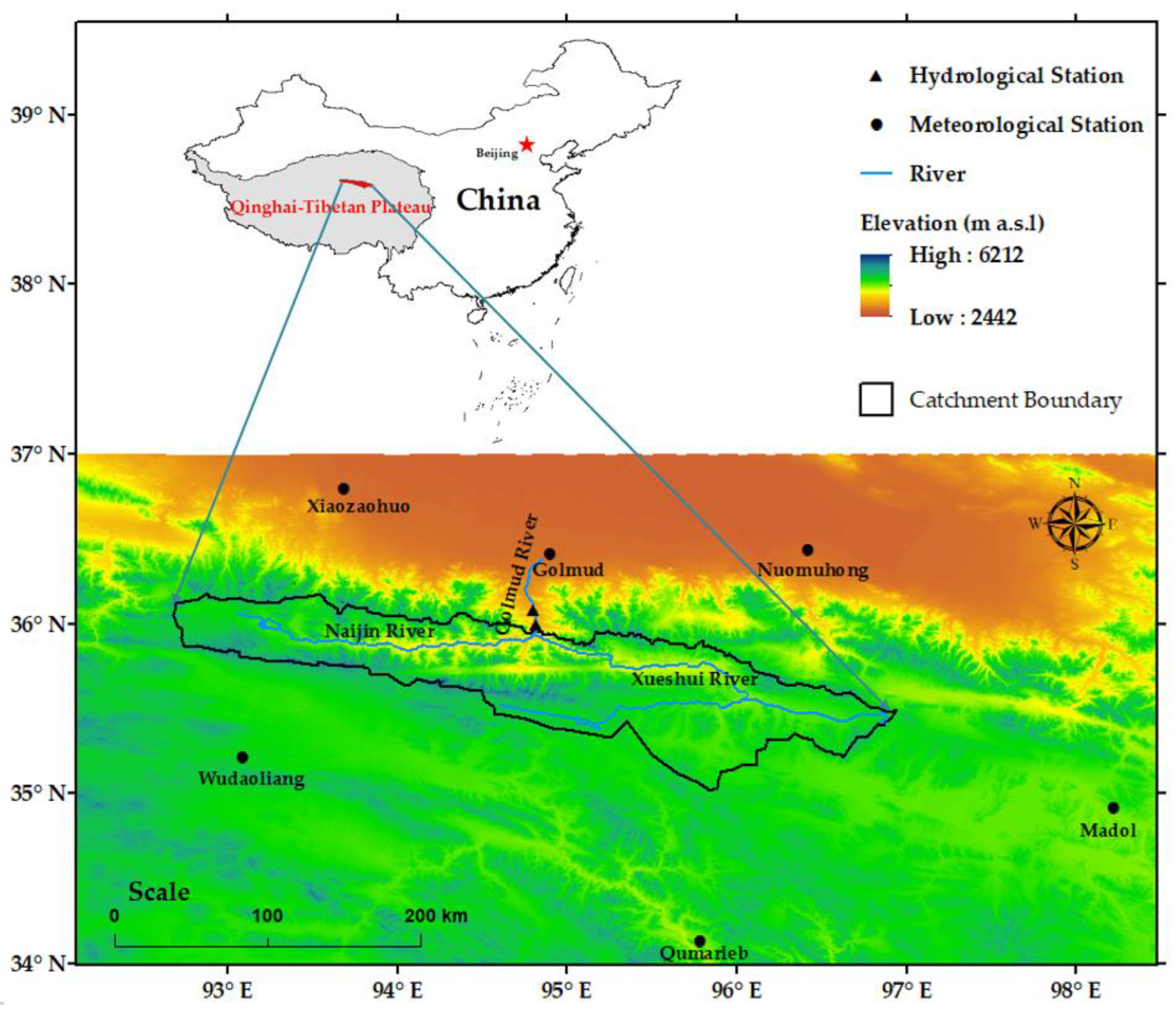



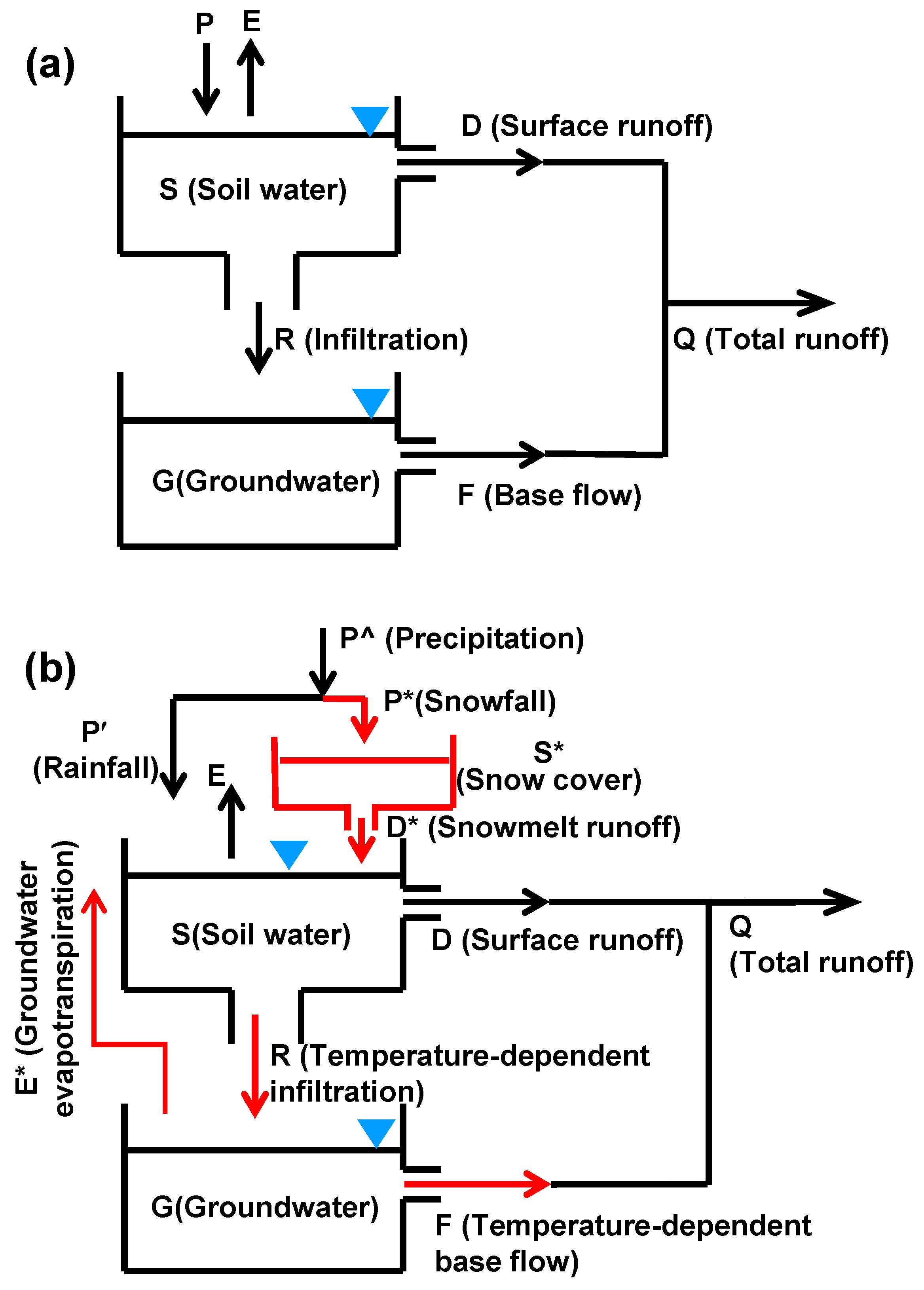

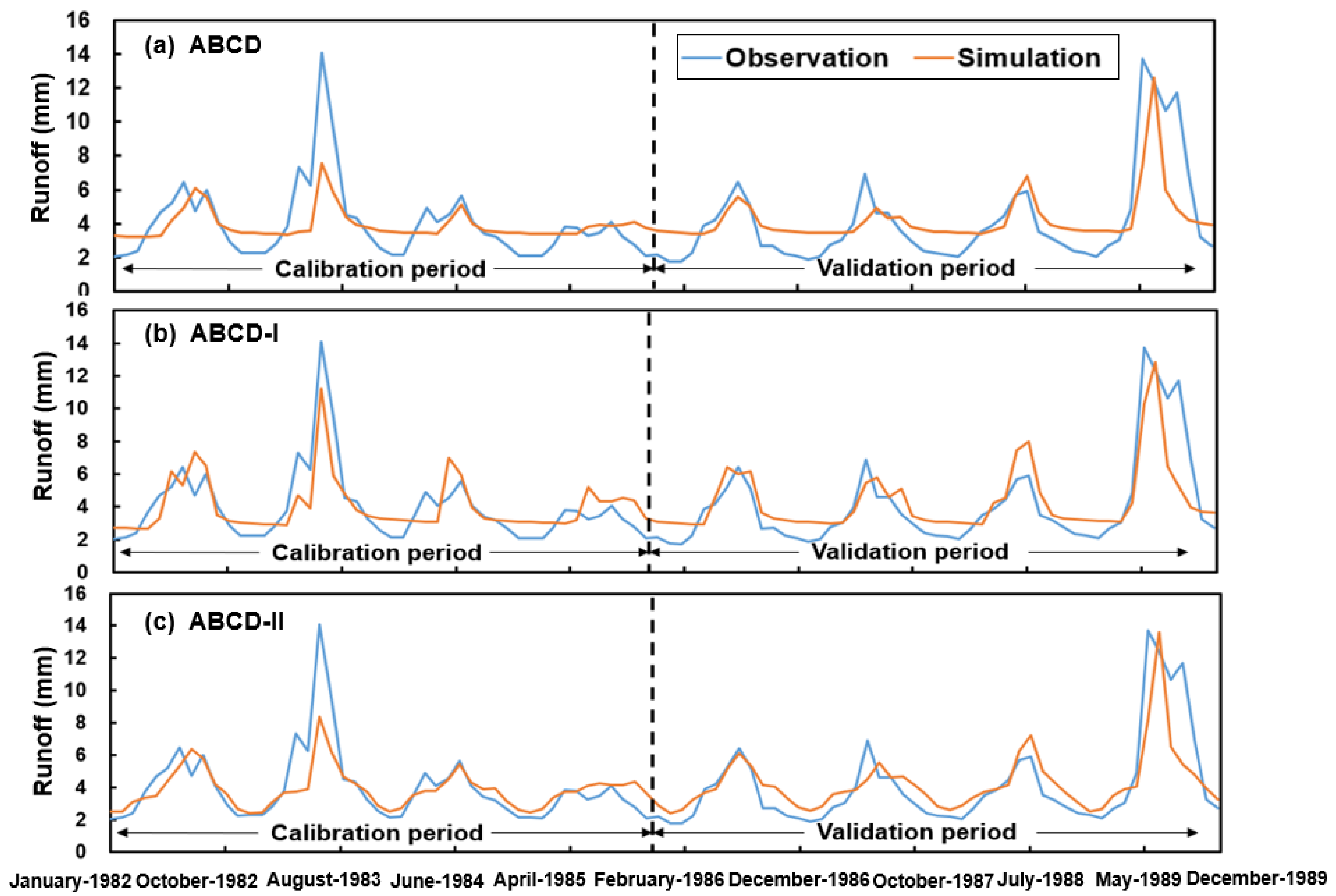
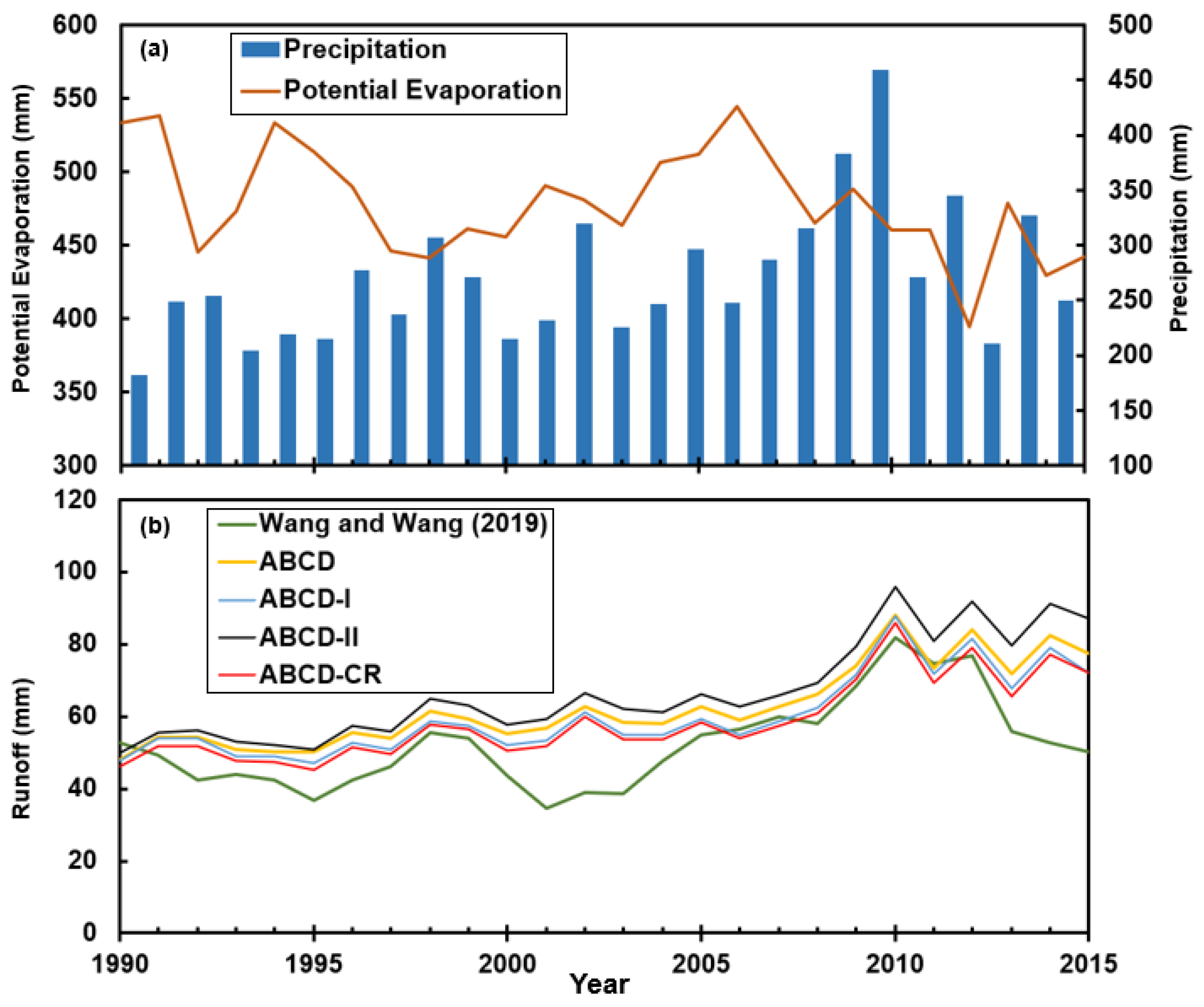
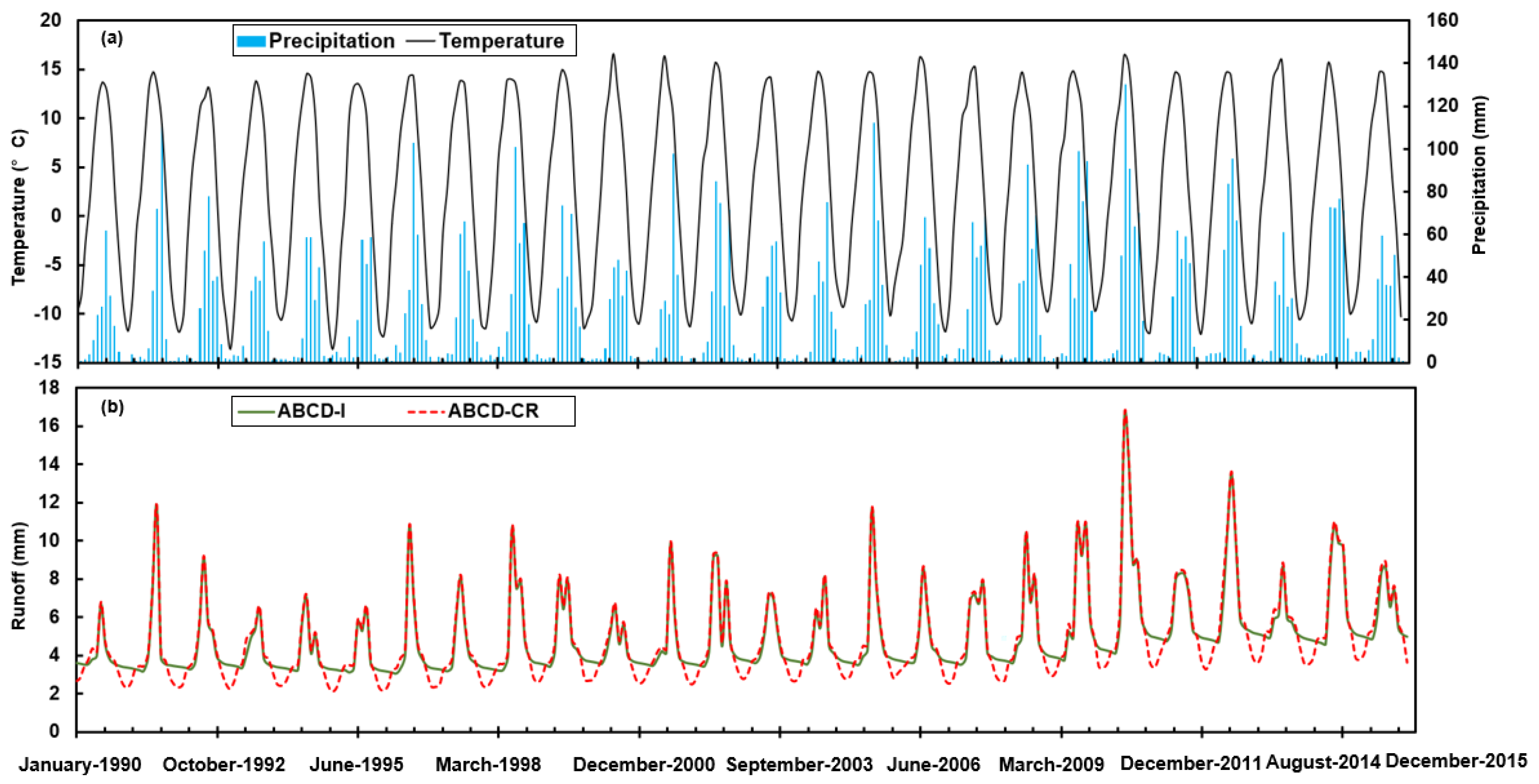
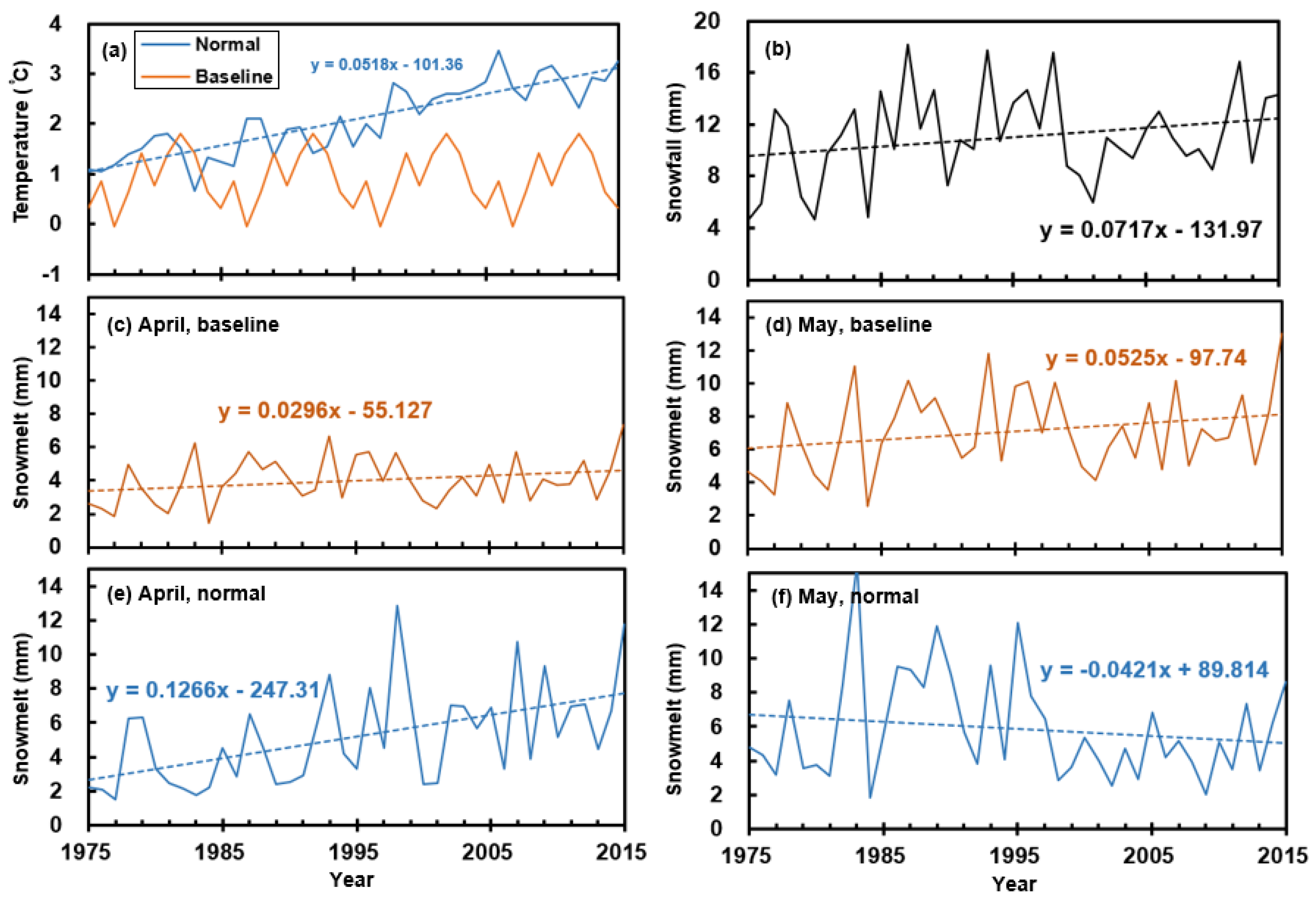
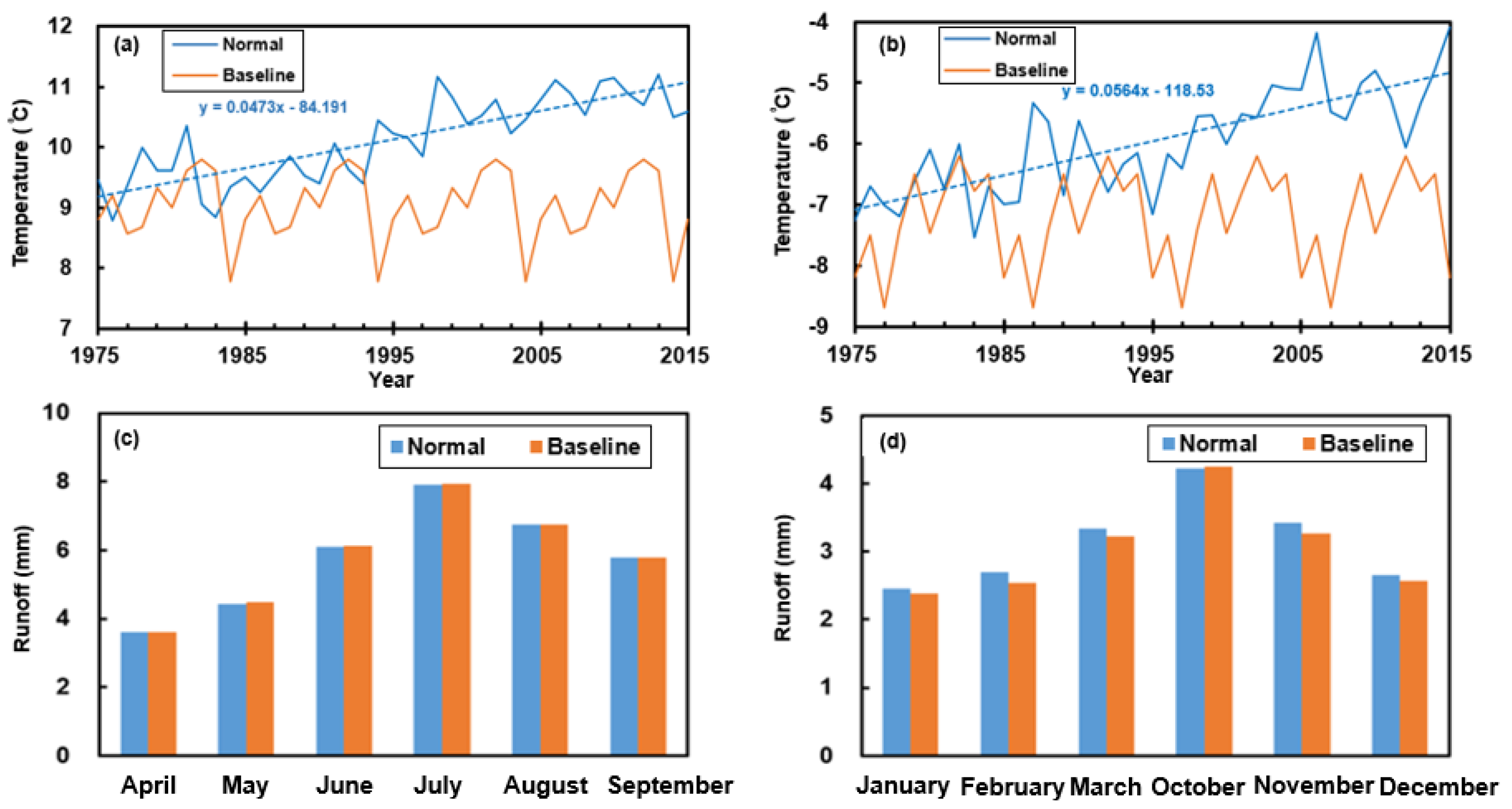
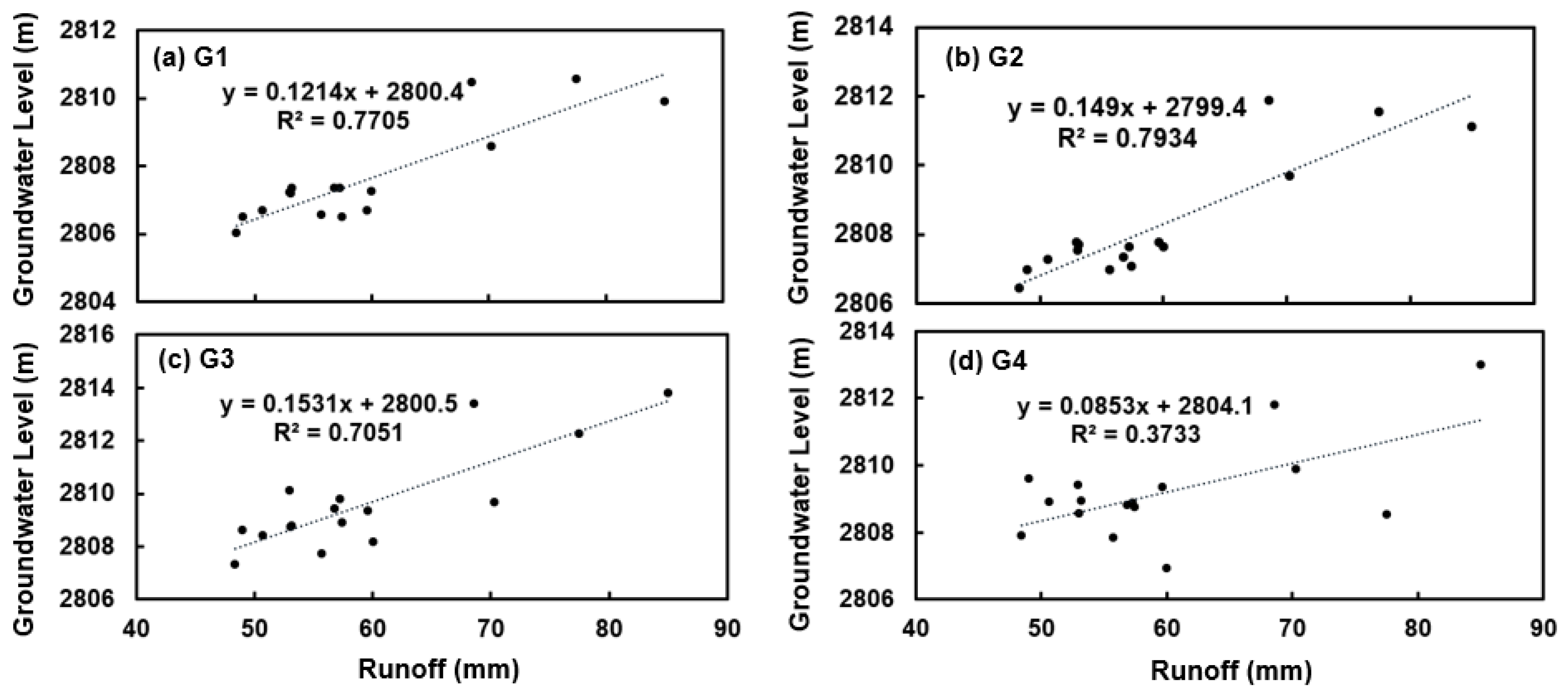
| Station | Xiaozaohuo | Golmud | Nuomuhong | Wudaoliang | Qumarleb | Madol |
|---|---|---|---|---|---|---|
| Altitude (m) | 2767.0 | 2807.6 | 2790.4 | 4612.2 | 4175.0 | 4272.3 |
| Mean annual P (mm) | 28.9 | 43.9 | 47.8 | 293.3 | 416.3 | 324.2 |
| Mean annual T (°C) | 3.9 | 5.5 | 5.1 | −5.1 | −1.9 | −3.5 |
| Mean annual E0 (mm) | 1570.0 | 1538.1 | 1351.9 | 795.6 | 770.6 | 881.6 |
| Trend in P (mm/yr) | +0.13 | +0.16 | +0.48 | +2.22 | +1.23 | +1.41 |
| Trend in T (°/a) | +0.06 | +0.05 | +0.04 | +0.03 | +0.04 | +0.04 |
| Trend in E0 (mm/yr) | +1.22 | −9.14 | −7.42 | −1.33 | +3.13 | +1.81 |
| Model | a | b (mm) | c0 | d0 | α (1/°C) | β (1/°C) | Gmax (103 mm) |
|---|---|---|---|---|---|---|---|
| ABCD Model | 0.8–1.0 (0.96) * | 20–160 (98) | 0.8–1.0 (0.911) | 0.001–0.01 (0.003) | 0 | / | ∞ |
| ABCD-I Model | 0.8–1.0 (0.84) | 20–160 (45) | 0.8–1.0 (0.933) | 0.001–0.01 (0.004) | 0 | / | 1–10 (5.2) |
| ABCD-II Model | 0.8–1.0 (0.97) | 20–160 (100) | 0.8–1.0 (0.923) | 0.001–0.01 (0.005) | 0.01–0.2 (0.038) | 0.01–0.2 (0.053) | ∞ |
| ABCD-CR Model | 0.8–1.0 (0.86) | 20–160 (43) | 0.8–1.0 (0.902) | 0.001–0.01 (0.004) | 0.01–0.2 (0.037) | 0.01–0.2 (0.142) | 1–10 (5.2) |
| Model | NSE | Error (MARE, %) | ||
|---|---|---|---|---|
| Calibration | Verification | Calibration | Verification | |
| ABCD Model | 0.47 | 0.55 | 30.07 | 35.81 |
| ABCD-I Model | 0.55 | 0.59 | 26.13 | 28.10 |
| ABCD-II Model | 0.63 | 0.66 | 19.11 | 26.32 |
| ABCD-CR | 0.72 | 0.72 | 17.53 | 17.25 |
| Periods | 1982–1989 | 1990–2000 | 2001–2015 | |
|---|---|---|---|---|
| Mean annual T (°C) | 1.43 | 1.98 | 2.82 | |
| Mean annual P (mm) | 268.5 | 238.8 | 293.9 | |
| Mean annual E0 (mm) | 483.1 | 484.7 | 474.8 | |
| Mean observed Q (mm) at W-III | 48.3 | null | null | |
| Mean observed Q (mm) at W-IV | null | 29.9 | 42.2 | |
| Mean annual results from the ABCD-CR model (mm) | E (E*) | 187.3 (52.94) | 188.9 (61.18) | 206.1 (70.64) |
| ΔS (S*) | −0.02 (12.30) | 0.03 (11.92) | −0.04 (11.12) | |
| D* | 12.2 | 12.1 | 11.3 | |
| ΔG | 33.52 | 0.09 | 23.84 | |
| Q | 47.7 | 50.1 | 64.1 | |
| Mean annual results from the ABCD model (mm) | E | 189.5 | 173.64 | 189.76 |
| ΔS | −0.18 | −0.05 | −0.15 | |
| ∆G | 27.13 | 11.36 | 35.17 | |
| Q | 48.7 | 53.88 | 69.09 | |
© 2020 by the authors. Licensee MDPI, Basel, Switzerland. This article is an open access article distributed under the terms and conditions of the Creative Commons Attribution (CC BY) license (http://creativecommons.org/licenses/by/4.0/).
Share and Cite
Wang, X.; Gao, B.; Wang, X. A Modified ABCD Model with Temperature-Dependent Parameters for Cold Regions: Application to Reconstruct the Changing Runoff in the Headwater Catchment of the Golmud River, China. Water 2020, 12, 1812. https://doi.org/10.3390/w12061812
Wang X, Gao B, Wang X. A Modified ABCD Model with Temperature-Dependent Parameters for Cold Regions: Application to Reconstruct the Changing Runoff in the Headwater Catchment of the Golmud River, China. Water. 2020; 12(6):1812. https://doi.org/10.3390/w12061812
Chicago/Turabian StyleWang, Xiaoshu, Bing Gao, and Xusheng Wang. 2020. "A Modified ABCD Model with Temperature-Dependent Parameters for Cold Regions: Application to Reconstruct the Changing Runoff in the Headwater Catchment of the Golmud River, China" Water 12, no. 6: 1812. https://doi.org/10.3390/w12061812
APA StyleWang, X., Gao, B., & Wang, X. (2020). A Modified ABCD Model with Temperature-Dependent Parameters for Cold Regions: Application to Reconstruct the Changing Runoff in the Headwater Catchment of the Golmud River, China. Water, 12(6), 1812. https://doi.org/10.3390/w12061812






